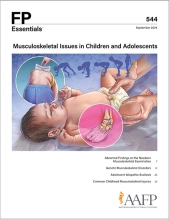
This clinical content conforms to AAFP criteria for CME.
Adolescent idiopathic scoliosis (AIS) is the most common type of scoliosis in children older than 10 years in the United States. AIS is defined as a lateral spine curvature of 10° or more in the coronal plane, without congenital or neuromuscular comorbidities. The U.S. Preventive Services Task Force (USPSTF) and American Academy of Family Physicians (AAFP) do not recommend for or against AIS screening in asymptomatic patients. Physical examination includes the forward bend test with or without scoliometer, wherein scoliometer rotation between 5° and 7° warrants further evaluation with x-rays. Definitive diagnosis with x-rays allows for measurement of the Cobb angle. For Cobb angles less than 20°, watchful waiting and/or referral for physical therapy are indicated. Referral to a spine specialist for bracing is reasonable for curves between 20° and 26° and is recommended for curves between 26° and 45°. Surgical intervention is considered for initial Cobb angles greater than 40° and recommended for Cobb angles greater than 50°.
Case 3. MG is an 11-year-old patient who is brought to your office for truncal asymmetry that his parents first noticed 3 months ago. MG is asymptomatic. His medical history, growth, and development have been normal. The forward bend test reveals right thoracic prominence. Using a scoliometer smartphone app, you measure the angle of trunk rotation as 7°. X-rays show thoracic scoliosis with a Cobb angle of 20°.
Definitions and Epidemiology
Subscribe
From $350- Immediate, unlimited access to FP Essentials content
- 60 CME credits/year
- AAFP app access
- Print delivery available
Edition Access
$44- Immediate, unlimited access to this edition's content
- 5 CME credits
- AAFP app access
- Print delivery available
